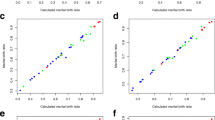Abstract
Much of the sharp rise in the share of nonmarital births in the United States has been attributed to changes in the fertility choices of unmarried and married women—in response, it is often argued, to public policy. In contrast, we develop and test a model that attributes the rise to changes in marriage behavior, with no necessary changes in fertility. A variety of empirical tests strongly support this conclusion and invites focused attention to issues related to marriage behavior as well as to the interactions between marriage and fertility.
Similar content being viewed by others
References
Baughman, R. and S. Dickert-Conlin. 2003. “Did Expanding the EITC Promote Motherhood?” American Economic Review, Papers and Proceedings 93:247–51.
Bitler, M., J. Gelbach, H. Hoynes, and M. Zavodny. 2004. “The Impact of Welfare Reform on Marriage and Divorce.” Demography 41:213–36.
Carlson, M., S. McLanahan, and P. England. 2004. “Union Formation in Fragile Families.” Demography 41:237–61.
Delaire, T. and A. Kalil. 2002. “Good Things Come in Threes: Single-Parent Multigenerational Family Structure and Adolescent Adjustment.” Demography 39:393–413.
Duncan, G. and S. Hoffman. 1990. “Welfare Benefits, Economic Opportunities, and Out-of-Wedlock Births Among Black Teenage Girls.” Demography 27:519–35.
Fitzgerald, J. and D. Ribar. 2004. “Welfare Reform and Female Headship.” Demography 41: 189–212.
Goldberg, E. 2001. The Executive Brain: Frontal Lobes and the Civilized Mind. Oxford: Oxford University Press.
Grogger, J. and S. Bronars. 2001. “The Effect of Welfare Payments on the Marriage and Fertility Behavior of Unwed Mothers: Results From a Twins Experiment.” Journal of Political Economy 109:529–45.
Kahn, J. and K. Anderson. 1992. “Intergenerational Patterns of Teenage Fertility.” Demography 29:39–57.
Kelley, A.E., T. Schochet, and C.F. Landry. 2004. “Risk Taking and Novelty Seeking in Adolescence.” Annals of the New York Academy of Science 1021:27–32.
Moffitt, R. 2000. “Welfare Benefits and Female Headship in U.S. Time Series.” American Economic Review 90:373–77.
National Center for Health Statistics. 2000. National Vital Statistics Reports 48(16). Available online at http://www.cdc.gov/nchs/data/nvsr/nvsr48/nvsr48_16.pdf
National Center for Health Statistics. 2002. National Vital Statistics Reports 50(10). Available online at http://www.cdc.gov/nchs/data/nvsr/nvsr50/nvsr50_10.pdf
National Center for Health Statistics. n.d. Vital Statistics of the United States. Available online at http://www.cdc.gov/nchs/births.htm
Sigle-Rushton, W. and S. McLanahan. 2002. “The Living Arrangements of New Unmarried Mothers.” Demography 39:415–33.
Simpson, E.H. 1951. “The Interpretation of Interaction in Contingency Tables.” Journal of the Royal Statistical Society, Series B 13:238–41.
Smith, H. and P. Cutright. 1988. “Thinking About Change in Illegitimacy Ratios: United States, 1963–1988.” Demography 25:235–47.
Smith, H., S. Morgan, and T. Koropeckyj-Cox. 1996. “A Decomposition of Trends in the Nonmarital Fertility Ratios of Blacks and Whites in the United States 1960–1992.” Demography 33:141–51.
Udry, J.R. 1994. “The Nature of Gender.” Demography 31:561–73.
— 2000. “Biological Limits of Gender Construction.” American Sociological Review 65: 443–57.
Upchurch, D., L. Lillard, and C. Panis. 2002. “Nonmarital Childbearing: Influences of Education, Marriage, and Fertility.” Demography 39:311–29.
U.S. Census Bureau. Various years. Current Population Reports, Series P-20. Available online at www. cdc.gov/nchs/births.htm
Author information
Authors and Affiliations
Additional information
The authors thank Herbert Smith, Larry Singell, Robert O’Brien, Stephen Haynes, Dan Hamermesh, and anonymous referees for valuable comments on earlier drafts of this article.
Rights and permissions
About this article
Cite this article
Gray, J.A., Stockard, J. & Stone, J. The rising share of nonmarital births: Fertility choice or marriage behavior?. Demography 43, 241–253 (2006). https://doi.org/10.1353/dem.2006.0012
Issue Date:
DOI: https://doi.org/10.1353/dem.2006.0012




